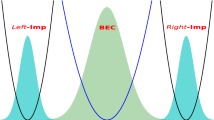Abstract
We study temperature effects on non-Markovian dynamics in a model of an atomic impurity qubit immersed in a quasi-two-dimensional dipolar Bose–Einstein condensate , which can be described as a pure dephasing spin-boson model. We use the measure proposed by Breuer et al. (Phys Rev Lett 103:210401, 2009) to characterize non-Markovianity of the quantum process and find for larger relative dipole–dipole interaction, properly low temperature can induce the non-Markovianity enhancement. We give an explanation of the non-Markovianity enhancement that raising temperature can increase the sharpness of the temperature-dependent environmental spectral density.



Similar content being viewed by others
References
H.P. Breuer, F. Petruccione, The Theory of Open Quantum Systems (Oxford University Press, Oxford, 2007)
H.P. Breuer, E.M. Laine, J. Piilo, Phys. Rev. Lett 103, 210401 (2009)
A. Rivas, S.F. Huelga, M.B. Plenio, Phys. Rev. Lett 105, 050403 (2010)
X.M. Lu, X.G. Wang, C.P. Sun, Phys. Rev. A 82, 042103 (2010)
H.S. Zeng, N. Tang, Y.P. Zheng, G.Y. Wang, Phys. Rev. A 84, 032118 (2011)
Z. He, J. Zou, L. Li, B. Shao, Phys. Rev. A 83, 012108 (2011)
M.M. Ali, P.Y. Lo, M.W.Y. Tu, W.M. Zhang, Phys. Rev. A 92, 062306 (2015)
H.P. Breuer, E.M. Laine, J. Piilo, B. Vacchini, Rev. Mod. Phys. 88, 021002 (2016)
A. Smirne, S. Cialdi, G. Anelli, M.G.A. Paris, B. Vacchini, Phys. Rev. A 88, 012108 (2013)
M. Gessner, M. Ramm, H. Häfner, A. Buchleitner, H.P. Breuer, Europhys. Lett. 107, 40005 (2014)
A.W. Chin, S.F. Huelga, M.B. Plenio, Phys. Rev. Lett. 109, 233601 (2012)
R. Vasile, S. Olivares, M.G.A. Paris, S. Maniscalco, Phys. Rev. A 83, 042321 (2011)
P. Rebentrost, A.A. Guzik, J. Chem. Phys. 134, 101103 (2011)
S.F. Huelga, A. Rivas, M.B. Plenio, Phys. Rev. Lett. 108, 160402 (2012)
F. Verstraete, M.M. Wolf, J.I. Cirac, Nat. Phys. 5, 633 (2009)
Y. Matsuzaki, S.C. Benjamin, J. Fitzsimons, Phys. Rev. A 84, 012103 (2011)
E.M. Laine, H.P. Breuer, J. Piilo, Sci. Rep. 4, 4620 (2014)
B.H. Liu et al., Nat. Phys. 7, 931 (2011)
J.S. Tang et al., Eur. Phys. Lett. 97, 10002 (2012)
A. Chiuri et al., Sci. Rep. 2, 968 (2012)
J.S. Xu et al., Nat. Commun. 4, 2851 (2013)
B.H. Liu et al., Sci. Rep. 3, 1781 (2013)
F. Fanchini et al., Phys. Rev. Lett. 112, 210402 (2014)
J. Jin et al., Phys. Rev. A 91, 012122 (2015)
N.K. Bernardes et al., Sci. Rep. 5, 17502 (2015)
P. Haikka et al., Phys. Rev. A 84, 031602(R) (2011)
P. Haikka et al., Phys. Rev. A 87, 012127 (2013)
P. Haikka et al., Phys. Rev. A 87, 010103(R) (2013)
P. Haikka et al., Phys. Scr. T 151, 014060 (2012)
S. Mcendoo et al., Eur.Phys. Lett. 101, 60005 (2013)
V. Pastukhov, J. Low Temp. Phys. 186, 148 (2017)
J. Li, Y. Qiao, J. Low Temp. Phys. 177, 165 (2014)
M. Pizzardo, G. Mazzarella, L. Salasnich, J. Low Temp. Phys. 185, 59 (2016)
B. Gonzlez-Fernndez, A. Camacho, J. Low Temp. Phys. 173, 343 (2013)
A. Klein, M. Fleischhauer, Phys. Rev. A 71, 033605 (2005)
A. Recati, P.O. Fedichev, W. Zwerger, J. von Delft, P. Zoller, Phys. Rev. Lett. 94, 040404 (2005)
H.T. Ng, S. Bose, Phys. Rev. A 78, 023610 (2008)
M. Bruderer, D. Jaksch, New J. Phys. 8, 87 (2006)
M.A. Cirone, G. De Chiara, G.M. Palma, A. Recati, New J. Phys. 11, 103055 (2009)
Ji-Bing Yuan, Hai-Jun Xing, Le-Man Kuang, Su Yi, Phys. Rev. A 95, 033610 (2017)
M. Lu et al., Phys. Rev. Lett. 107, 190401 (2011)
M. Lu et al., Phys. Rev. Lett. 108, 215301 (2012)
C. Chin, R. Grimm, P. Julienne, E. Tiesinga, Rev. Mod. Phys. 82, 1225 (2010)
Acknowledgements
This work was supported by the National Natural Science Foundation of China under Grants Nos. 11547258 and 11647129, by the Scientific Research Fund of Hunan Provincial Education Department of China under Grants Nos. 16B036 and 15A028, by Hunan Provincial Natural Science Foundation of China under Grants Nos. 2017JJ3005, 2016JJ2009 and 2015JJ3029, by the Science and Technology Plan Project of Hunan Province Grant No. 2016TP1020, by Science Foundation of Hengyang Normal University of China under Grants Nos. 15B21 and 14B38 and by the Hunan Provincial Applied Basic Research Base of Optoelectronic Information Technology Grant No. GD16K05.
Author information
Authors and Affiliations
Corresponding author
Rights and permissions
About this article
Cite this article
Tang, SQ., Yuan, JB., Wang, XW. et al. Temperature Can Enhance Non-Markovianity in Dipolar Bose–Einstein Condensate. J Low Temp Phys 189, 147–157 (2017). https://doi.org/10.1007/s10909-017-1797-8
Received:
Accepted:
Published:
Issue Date:
DOI: https://doi.org/10.1007/s10909-017-1797-8




